作為一名開發(fā)人員我們經(jīng)常會聽到HTTP協(xié)議、TCP/IP協(xié)議、UDP協(xié)議、Socket、Socket長連接、Socket連接池等字眼,然而它們之間的關(guān)系、區(qū)別及原理并不是所有人都能理解清楚,這篇文章就從網(wǎng)絡(luò)協(xié)議基礎(chǔ)開始到Socket連接池,一步一步解釋他們之間的關(guān)系。
七層網(wǎng)絡(luò)模型
首先從網(wǎng)絡(luò)通信的分層模型講起:七層模型,亦稱OSI(Open System Interconnection)模型。自下往上分為:物理層、數(shù)據(jù)鏈路層、網(wǎng)絡(luò)層、傳輸層、會話層、表示層和應(yīng)用層。所有有關(guān)通信的都離不開它,下面這張圖片介紹了各層所對應(yīng)的一些協(xié)議和硬件
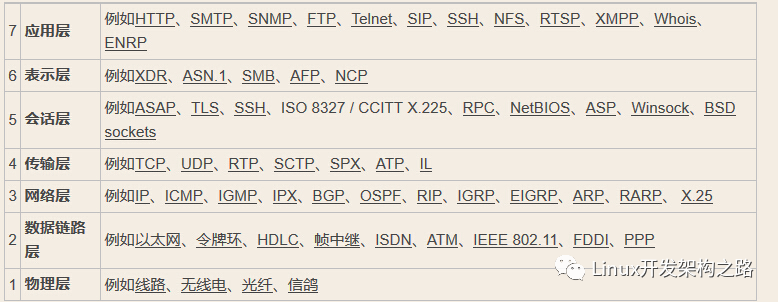
通過上圖,我知道IP協(xié)議對應(yīng)于網(wǎng)絡(luò)層,TCP、UDP協(xié)議對應(yīng)于傳輸層,而HTTP協(xié)議對應(yīng)于應(yīng)用層,OSI并沒有Socket,那什么是Socket,后面我們將結(jié)合代碼具體詳細(xì)介紹。
TCP和UDP連接
關(guān)于傳輸層TCP、UDP協(xié)議可能我們平時遇見的會比較多,有人說TCP是安全的,UDP是不安全的,UDP傳輸比TCP快,那為什么呢,我們先從TCP的連接建立的過程開始分析,然后解釋UDP和TCP的區(qū)別。
TCP的三次握手和四次分手
我們知道TCP建立連接需要經(jīng)過三次握手,而斷開連接需要經(jīng)過四次分手,那三次握手和四次分手分別做了什么和如何進(jìn)行的。
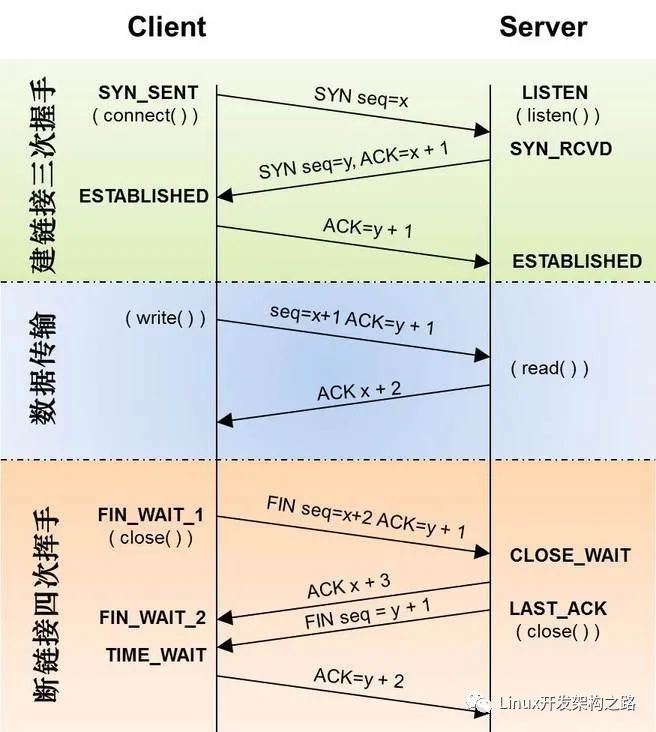
第一次握手:建立連接。客戶端發(fā)送連接請求報文段,將SYN位置為1,Sequence Number為x;然后,客戶端進(jìn)入SYN_SEND狀態(tài),等待服務(wù)器的確認(rèn);
第二次握手:服務(wù)器收到客戶端的SYN報文段,需要對這個SYN報文段進(jìn)行確認(rèn),設(shè)置Acknowledgment Number為x+1(Sequence Number+1);同時,自己自己還要發(fā)送SYN請求信息,將SYN位置為1,Sequence Number為y;服務(wù)器端將上述所有信息放到一個報文段(即SYN+ACK報文段)中,一并發(fā)送給客戶端,此時服務(wù)器進(jìn)入SYN_RECV狀態(tài);
第三次握手:客戶端收到服務(wù)器的SYN+ACK報文段。然后將Acknowledgment Number設(shè)置為y+1,向服務(wù)器發(fā)送ACK報文段,這個報文段發(fā)送完畢以后,客戶端和服務(wù)器端都進(jìn)入ESTABLISHED狀態(tài),完成TCP三次握手。
完成了三次握手,客戶端和服務(wù)器端就可以開始傳送數(shù)據(jù)。以上就是TCP三次握手的總體介紹。通信結(jié)束客戶端和服務(wù)端就斷開連接,需要經(jīng)過四次分手確認(rèn)。
第一次分手:主機(jī)1(可以使客戶端,也可以是服務(wù)器端),設(shè)置Sequence Number和Acknowledgment Number,向主機(jī)2發(fā)送一個FIN報文段;此時,主機(jī)1進(jìn)入FIN_WAIT_1狀態(tài);這表示主機(jī)1沒有數(shù)據(jù)要發(fā)送給主機(jī)2了;
第二次分手:主機(jī)2收到了主機(jī)1發(fā)送的FIN報文段,向主機(jī)1回一個ACK報文段,Acknowledgment Number為Sequence Number加1;主機(jī)1進(jìn)入FIN_WAIT_2狀態(tài);主機(jī)2告訴主機(jī)1,我“同意”你的關(guān)閉請求;
第三次分手:主機(jī)2向主機(jī)1發(fā)送FIN報文段,請求關(guān)閉連接,同時主機(jī)2進(jìn)入LAST_ACK狀態(tài);
第四次分手:主機(jī)1收到主機(jī)2發(fā)送的FIN報文段,向主機(jī)2發(fā)送ACK報文段,然后主機(jī)1進(jìn)入TIME_WAIT狀態(tài);主機(jī)2收到主機(jī)1的ACK報文段以后,就關(guān)閉連接;此時,主機(jī)1等待2MSL后依然沒有收到回復(fù),則證明Server端已正常關(guān)閉,那好,主機(jī)1也可以關(guān)閉連接了。
可以看到一次tcp請求的建立及關(guān)閉至少進(jìn)行7次通信,這還不包過數(shù)據(jù)的通信,而UDP不需3次握手和4次分手。
TCP和UDP的區(qū)別
1、TCP是面向鏈接的,雖然說網(wǎng)絡(luò)的不安全不穩(wěn)定特性決定了多少次握手都不能保證連接的可靠性,但TCP的三次握手在最低限度上(實際上也很大程度上保證了)保證了連接的可靠性;而UDP不是面向連接的,UDP傳送數(shù)據(jù)前并不與對方建立連接,對接收到的數(shù)據(jù)也不發(fā)送確認(rèn)信號,發(fā)送端不知道數(shù)據(jù)是否會正確接收,當(dāng)然也不用重發(fā),所以說UDP是無連接的、不可靠的一種數(shù)據(jù)傳輸協(xié)議。
2、也正由于1所說的特點,使得UDP的開銷更小數(shù)據(jù)傳輸速率更高,因為不必進(jìn)行收發(fā)數(shù)據(jù)的確認(rèn),所以UDP的實時性更好。知道了TCP和UDP的區(qū)別,就不難理解為何采用TCP傳輸協(xié)議的MSN比采用UDP的QQ傳輸文件慢了,但并不能說QQ的通信是不安全的,因為程序員可以手動對UDP的數(shù)據(jù)收發(fā)進(jìn)行驗證,比如發(fā)送方對每個數(shù)據(jù)包進(jìn)行編號然后由接收方進(jìn)行驗證啊什么的,即使是這樣,UDP因為在底層協(xié)議的封裝上沒有采用類似TCP的“三次握手”而實現(xiàn)了TCP所無法達(dá)到的傳輸效率。
問題
關(guān)于傳輸層我們會經(jīng)常聽到一些問題
1.TCP服務(wù)器最大并發(fā)連接數(shù)是多少?
關(guān)于TCP服務(wù)器最大并發(fā)連接數(shù)有一種誤解就是“因為端口號上限為65535,所以TCP服務(wù)器理論上的可承載的最大并發(fā)連接數(shù)也是65535”。首先需要理解一條TCP連接的組成部分:客戶端IP、客戶端端口、服務(wù)端IP、服務(wù)端端口。所以對于TCP服務(wù)端進(jìn)程來說,他可以同時連接的客戶端數(shù)量并不受限于可用端口號,理論上一個服務(wù)器的一個端口能建立的連接數(shù)是全球的IP數(shù)*每臺機(jī)器的端口數(shù)。實際并發(fā)連接數(shù)受限于linux可打開文件數(shù),這個數(shù)是可以配置的,可以非常大,所以實際上受限于系統(tǒng)性能。通過#ulimit -n 查看服務(wù)的最大文件句柄數(shù),通過ulimit -n xxx 修改 xxx是你想要能打開的數(shù)量。也可以通過修改系統(tǒng)參數(shù):
#vi /etc/security/limits.conf
*softnofile65536
*hardnofile65536
2.為什么TIME_WAIT狀態(tài)還需要等2MSL后才能返回到CLOSED狀態(tài)?
這是因為雖然雙方都同意關(guān)閉連接了,而且握手的4個報文也都協(xié)調(diào)和發(fā)送完畢,按理可以直接回到CLOSED狀態(tài)(就好比從SYN_SEND狀態(tài)到ESTABLISH狀態(tài)那樣);但是因為我們必須要假想網(wǎng)絡(luò)是不可靠的,你無法保證你最后發(fā)送的ACK報文會一定被對方收到,因此對方處于LAST_ACK狀態(tài)下的Socket可能會因為超時未收到ACK報文,而重發(fā)FIN報文,所以這個TIME_WAIT狀態(tài)的作用就是用來重發(fā)可能丟失的ACK報文。
3.TIME_WAIT狀態(tài)還需要等2MSL后才能返回到CLOSED狀態(tài)會產(chǎn)生什么問題
通信雙方建立TCP連接后,主動關(guān)閉連接的一方就會進(jìn)入TIME_WAIT狀態(tài),TIME_WAIT狀態(tài)維持時間是兩個MSL時間長度,也就是在1-4分鐘,Windows操作系統(tǒng)就是4分鐘。進(jìn)入TIME_WAIT狀態(tài)的一般情況下是客戶端,一個TIME_WAIT狀態(tài)的連接就占用了一個本地端口。一臺機(jī)器上端口號數(shù)量的上限是65536個,如果在同一臺機(jī)器上進(jìn)行壓力測試模擬上萬的客戶請求,并且循環(huán)與服務(wù)端進(jìn)行短連接通信,那么這臺機(jī)器將產(chǎn)生4000個左右的TIME_WAIT Socket,后續(xù)的短連接就會產(chǎn)生address already in use : connect的異常,如果使用Nginx作為方向代理也需要考慮TIME_WAIT狀態(tài),發(fā)現(xiàn)系統(tǒng)存在大量TIME_WAIT狀態(tài)的連接,通過調(diào)整內(nèi)核參數(shù)解決。
vi /etc/sysctl.conf
編輯文件,加入以下內(nèi)容:
net.ipv4.tcp_syncookies = 1
net.ipv4.tcp_tw_reuse = 1
net.ipv4.tcp_tw_recycle = 1
net.ipv4.tcp_fin_timeout = 30
然后執(zhí)行 /sbin/sysctl -p 讓參數(shù)生效。
net.ipv4.tcp_syncookies = 1 表示開啟SYN Cookies。當(dāng)出現(xiàn)SYN等待隊列溢出時,啟用cookies來處理,可防范少量SYN攻擊,默認(rèn)為0,表示關(guān)閉;
net.ipv4.tcp_tw_reuse = 1 表示開啟重用。允許將TIME-WAIT sockets重新用于新的TCP連接,默認(rèn)為0,表示關(guān)閉;
net.ipv4.tcp_tw_recycle = 1 表示開啟TCP連接中TIME-WAIT sockets的快速回收,默認(rèn)為0,表示關(guān)閉。
net.ipv4.tcp_fin_timeout 修改系統(tǒng)默認(rèn)的TIMEOUT時間
HTTP協(xié)議
關(guān)于TCP/IP和HTTP協(xié)議的關(guān)系,網(wǎng)絡(luò)有一段比較容易理解的介紹:“我們在傳輸數(shù)據(jù)時,可以只使用(傳輸層)TCP/IP協(xié)議,但是那樣的話,如果沒有應(yīng)用層,便無法識別數(shù)據(jù)內(nèi)容。如果想要使傳輸?shù)臄?shù)據(jù)有意義,則必須使用到應(yīng)用層協(xié)議。應(yīng)用層協(xié)議有很多,比如HTTP、FTP、TELNET等,也可以自己定義應(yīng)用層協(xié)議。
HTTP協(xié)議即超文本傳送協(xié)議(Hypertext Transfer Protocol ),是Web聯(lián)網(wǎng)的基礎(chǔ),也是手機(jī)聯(lián)網(wǎng)常用的協(xié)議之一,WEB使用HTTP協(xié)議作應(yīng)用層協(xié)議,以封裝HTTP文本信息,然后使用TCP/IP做傳輸層協(xié)議將它發(fā)到網(wǎng)絡(luò)上。
由于HTTP在每次請求結(jié)束后都會主動釋放連接,因此HTTP連接是一種“短連接”,要保持客戶端程序的在線狀態(tài),需要不斷地向服務(wù)器發(fā)起連接請求。通常 的做法是即時不需要獲得任何數(shù)據(jù),客戶端也保持每隔一段固定的時間向服務(wù)器發(fā)送一次“保持連接”的請求,服務(wù)器在收到該請求后對客戶端進(jìn)行回復(fù),表明知道 客戶端“在線”。若服務(wù)器長時間無法收到客戶端的請求,則認(rèn)為客戶端“下線”,若客戶端長時間無法收到服務(wù)器的回復(fù),則認(rèn)為網(wǎng)絡(luò)已經(jīng)斷開。
下面是一個簡單的HTTP Post application/json數(shù)據(jù)內(nèi)容的請求:
POST HTTP/1.1
Host: 127.0.0.1:9017
Content-Type: application/json
Cache-Control: no-cache
{"a":"a"}
關(guān)于Socket(套接字)
現(xiàn)在我們了解到TCP/IP只是一個協(xié)議棧,就像操作系統(tǒng)的運行機(jī)制一樣,必須要具體實現(xiàn),同時還要提供對外的操作接口。就像操作系統(tǒng)會提供標(biāo)準(zhǔn)的編程接口,比如Win32編程接口一樣,TCP/IP也必須對外提供編程接口,這就是Socket。現(xiàn)在我們知道,Socket跟TCP/IP并沒有必然的聯(lián)系。Socket編程接口在設(shè)計的時候,就希望也能適應(yīng)其他的網(wǎng)絡(luò)協(xié)議。所以,Socket的出現(xiàn)只是可以更方便的使用TCP/IP協(xié)議棧而已,其對TCP/IP進(jìn)行了抽象,形成了幾個最基本的函數(shù)接口。比如create,listen,accept,connect,read和write等等。
不同語言都有對應(yīng)的建立Socket服務(wù)端和客戶端的庫,下面舉例Nodejs如何創(chuàng)建服務(wù)端和客戶端:
服務(wù)端:
const net = require('net');
const server = net.createServer();
server.on('connection', (client) = > {
client.write('Hi!n'); // 服務(wù)端向客戶端輸出信息,使用 write() 方法
client.write('Bye!n');
//client.end(); // 服務(wù)端結(jié)束該次會話
});
server.listen(9000);
服務(wù)監(jiān)聽9000端口
下面使用命令行發(fā)送http請求和telnet
$ curl http://127.0.0.1:9000
Bye!
$telnet 127.0.0.1 9000
Trying 192.168.1.21...
Connected to 192.168.1.21.
Escape character is '^]'.
Hi!
Bye!
Connection closed by foreign host.
注意到curl只處理了一次報文。
客戶端
const client = new net.Socket();
client.connect(9000, '127.0.0.1', function () {
});
client.on('data', (chunk) = > {
console.log('data', chunk.toString())
//data Hi!
//Bye!
});
Socket長連接
所謂長連接,指在一個TCP連接上可以連續(xù)發(fā)送多個數(shù)據(jù)包,在TCP連接保持期間,如果沒有數(shù)據(jù)包發(fā)送,需要雙方發(fā)檢測包以維持此連接(心跳包),一般需要自己做在線維持。 短連接是指通信雙方有數(shù)據(jù)交互時,就建立一個TCP連接,數(shù)據(jù)發(fā)送完成后,則斷開此TCP連接。比如Http的,只是連接、請求、關(guān)閉,過程時間較短,服務(wù)器若是一段時間內(nèi)沒有收到請求即可關(guān)閉連接。其實長連接是相對于通常的短連接而說的,也就是長時間保持客戶端與服務(wù)端的連接狀態(tài)。
通常的短連接操作步驟是:
連接→數(shù)據(jù)傳輸→關(guān)閉連接;
而長連接通常就是:
連接→數(shù)據(jù)傳輸→保持連接(心跳)→數(shù)據(jù)傳輸→保持連接(心跳)→……→關(guān)閉連接;
什么時候用長連接,短連接?
長連接多用于操作頻繁,點對點的通訊,而且連接數(shù)不能太多情況,。每個TCP連接都需要三步握手,這需要時間,如果每個操作都是先連接,再操作的話那么處理 速度會降低很多,所以每個操作完后都不斷開,次處理時直接發(fā)送數(shù)據(jù)包就OK了,不用建立TCP連接。例如:數(shù)據(jù)庫的連接用長連接, 如果用短連接頻繁的通信會造成Socket錯誤,而且頻繁的Socket創(chuàng)建也是對資源的浪費。
什么是心跳包為什么需要:
心跳包就是在客戶端和服務(wù)端間定時通知對方自己狀態(tài)的一個自己定義的命令字,按照一定的時間間隔發(fā)送,類似于心跳,所以叫做心跳包。網(wǎng)絡(luò)中的接收和發(fā)送數(shù)據(jù)都是使用Socket進(jìn)行實現(xiàn)。但是如果此套接字已經(jīng)斷開(比如一方斷網(wǎng)了),那發(fā)送數(shù)據(jù)和接收數(shù)據(jù)的時候就一定會有問題。可是如何判斷這個套接字是否還可以使用呢?這個就需要在系統(tǒng)中創(chuàng)建心跳機(jī)制。其實TCP中已經(jīng)為我們實現(xiàn)了一個叫做心跳的機(jī)制。如果你設(shè)置了心跳,那TCP就會在一定的時間(比如你設(shè)置的是3秒鐘)內(nèi)發(fā)送你設(shè)置的次數(shù)的心跳(比如說2次),并且此信息不會影響你自己定義的協(xié)議。也可以自己定義,所謂“心跳”就是定時發(fā)送一個自定義的結(jié)構(gòu)體(心跳包或心跳幀),讓對方知道自己“在線”,以確保鏈接的有效性。
實現(xiàn):
服務(wù)端:
const net = require('net');
let clientList = [];
const heartbeat = 'HEARTBEAT'; // 定義心跳包內(nèi)容確保和平時發(fā)送的數(shù)據(jù)不會沖突
const server = net.createServer();
server.on('connection', (client) = > {
console.log('客戶端建立連接:', client.remoteAddress + ':' + client.remotePort);
clientList.push(client);
client.on('data', (chunk) = > {
let content = chunk.toString();
if (content === heartbeat) {
console.log('收到客戶端發(fā)過來的一個心跳包');
} else {
console.log('收到客戶端發(fā)過來的數(shù)據(jù):', content);
client.write('服務(wù)端的數(shù)據(jù):' + content);
}
});
client.on('end', () = > {
console.log('收到客戶端end');
clientList.splice(clientList.indexOf(client), 1);
});
client.on('error', () = > {
clientList.splice(clientList.indexOf(client), 1);
})
});
server.listen(9000);
setInterval(broadcast, 10000); // 定時發(fā)送心跳包
function broadcast() {
console.log('broadcast heartbeat', clientList.length);
let cleanup = []
for (let i=0;i< clientList.length;i+=1) {
if (clientList[i].writable) { // 先檢查 sockets 是否可寫
clientList[i].write(heartbeat);
} else {
console.log('一個無效的客戶端');
cleanup.push(clientList[i]); // 如果不可寫,收集起來銷毀。銷毀之前要 Socket.destroy() 用 API 的方法銷毀。
clientList[i].destroy();
}
}
//Remove dead Nodes out of write loop to avoid trashing loop index
for (let i=0; i< cleanup.length; i+=1) {
console.log('刪除無效的客戶端:', cleanup[i].name);
clientList.splice(clientList.indexOf(cleanup[i]), 1);
}
}
服務(wù)端輸出結(jié)果:
客戶端建立連接: ::ffff:127.0.0.1:57125
broadcast heartbeat 1
收到客戶端發(fā)過來的數(shù)據(jù): Thu, 29 Mar 2018 03:45:15 GMT
收到客戶端發(fā)過來的一個心跳包
收到客戶端發(fā)過來的數(shù)據(jù): Thu, 29 Mar 2018 03:45:20 GMT
broadcast heartbeat 1
收到客戶端發(fā)過來的數(shù)據(jù): Thu, 29 Mar 2018 03:45:25 GMT
收到客戶端發(fā)過來的一個心跳包
客戶端建立連接: ::ffff:127.0.0.1:57129
收到客戶端發(fā)過來的一個心跳包
收到客戶端發(fā)過來的數(shù)據(jù): Thu, 29 Mar 2018 03:46:00 GMT
收到客戶端發(fā)過來的數(shù)據(jù): Thu, 29 Mar 2018 03:46:04 GMT
broadcast heartbeat 2
收到客戶端發(fā)過來的數(shù)據(jù): Thu, 29 Mar 2018 03:46:05 GMT
收到客戶端發(fā)過來的一個心跳包
客戶端代碼:
const net = require('net');
const heartbeat = 'HEARTBEAT';
const client = new net.Socket();
client.connect(9000, '127.0.0.1', () = > {});
client.on('data', (chunk) = > {
let content = chunk.toString();
if (content === heartbeat) {
console.log('收到心跳包:', content);
} else {
console.log('收到數(shù)據(jù):', content);
}
});
// 定時發(fā)送數(shù)據(jù)
setInterval(() = > {
console.log('發(fā)送數(shù)據(jù)', new Date().toUTCString());
client.write(new Date().toUTCString());
}, 5000);
// 定時發(fā)送心跳包
setInterval(function () {
client.write(heartbeat);
}, 10000);
客戶端輸出結(jié)果:
發(fā)送數(shù)據(jù) Thu, 29 Mar 2018 03:46:04 GMT
收到數(shù)據(jù): 服務(wù)端的數(shù)據(jù):Thu, 29 Mar 2018 03:46:04 GMT
收到心跳包: HEARTBEAT
發(fā)送數(shù)據(jù) Thu, 29 Mar 2018 03:46:09 GMT
收到數(shù)據(jù): 服務(wù)端的數(shù)據(jù):Thu, 29 Mar 2018 03:46:09 GMT
發(fā)送數(shù)據(jù) Thu, 29 Mar 2018 03:46:14 GMT
收到數(shù)據(jù): 服務(wù)端的數(shù)據(jù):Thu, 29 Mar 2018 03:46:14 GMT
收到心跳包: HEARTBEAT
發(fā)送數(shù)據(jù) Thu, 29 Mar 2018 03:46:19 GMT
收到數(shù)據(jù): 服務(wù)端的數(shù)據(jù):Thu, 29 Mar 2018 03:46:19 GMT
發(fā)送數(shù)據(jù) Thu, 29 Mar 2018 03:46:24 GMT
收到數(shù)據(jù): 服務(wù)端的數(shù)據(jù):Thu, 29 Mar 2018 03:46:24 GMT
收到心跳包: HEARTBEAT
定義自己的協(xié)議
如果想要使傳輸?shù)臄?shù)據(jù)有意義,則必須使用到應(yīng)用層協(xié)議比如Http、Mqtt、Dubbo等。基于TCP協(xié)議上自定義自己的應(yīng)用層的協(xié)議需要解決的幾個問題:
- 心跳包格式的定義及處理
- 報文頭的定義,就是你發(fā)送數(shù)據(jù)的時候需要先發(fā)送報文頭,報文里面能解析出你將要發(fā)送的數(shù)據(jù)長度
- 你發(fā)送數(shù)據(jù)包的格式,是json的還是其他序列化的方式
下面我們就一起來定義自己的協(xié)議,并編寫服務(wù)的和客戶端進(jìn)行調(diào)用:
定義報文頭格式: length:000000000xxxx; xxxx代表數(shù)據(jù)的長度,總長度20,舉例子不嚴(yán)謹(jǐn)。
數(shù)據(jù)表的格式: Json
服務(wù)端:
const net = require('net');
const server = net.createServer();
let clientList = [];
const heartBeat = 'HeartBeat'; // 定義心跳包內(nèi)容確保和平時發(fā)送的數(shù)據(jù)不會沖突
const getHeader = (num) = > {
return 'length:' + (Array(13).join(0) + num).slice(-13);
}
server.on('connection', (client) = > {
client.name = client.remoteAddress + ':' + client.remotePort
// client.write('Hi ' + client.name + '!n');
console.log('客戶端建立連接', client.name);
clientList.push(client)
let chunks = [];
let length = 0;
client.on('data', (chunk) = > {
let content = chunk.toString();
console.log("content:", content, content.length);
if (content === heartBeat) {
console.log('收到客戶端發(fā)過來的一個心跳包');
} else {
if (content.indexOf('length:') === 0){
length = parseInt(content.substring(7,20));
console.log('length', length);
chunks =[chunk.slice(20, chunk.length)];
} else {
chunks.push(chunk);
}
let heap = Buffer.concat(chunks);
console.log('heap.length', heap.length)
if (heap.length >= length) {
try {
console.log('收到數(shù)據(jù)', JSON.parse(heap.toString()));
let data = '服務(wù)端的數(shù)據(jù)數(shù)據(jù):' + heap.toString();;
let dataBuff = Buffer.from(JSON.stringify(data));
let header = getHeader(dataBuff.length)
client.write(header);
client.write(dataBuff);
} catch (err) {
console.log('數(shù)據(jù)解析失敗');
}
}
}
})
client.on('end', () = > {
console.log('收到客戶端end');
clientList.splice(clientList.indexOf(client), 1);
});
client.on('error', () = > {
clientList.splice(clientList.indexOf(client), 1);
})
});
server.listen(9000);
setInterval(broadcast, 10000); // 定時檢查客戶端 并發(fā)送心跳包
function broadcast() {
console.log('broadcast heartbeat', clientList.length);
let cleanup = []
for(var i=0;i< clientList.length;i+=1) {
if(clientList[i].writable) { // 先檢查 sockets 是否可寫
// clientList[i].write(heartBeat); // 發(fā)送心跳數(shù)據(jù)
} else {
console.log('一個無效的客戶端')
cleanup.push(clientList[i]) // 如果不可寫,收集起來銷毀。銷毀之前要 Socket.destroy() 用 API 的方法銷毀。
clientList[i].destroy();
}
}
// 刪除無效的客戶端
for(i=0; i< cleanup.length; i+=1) {
console.log('刪除無效的客戶端:', cleanup[i].name);
clientList.splice(clientList.indexOf(cleanup[i]), 1)
}
}
日志打印:
客戶端建立連接 ::ffff:127.0.0.1:50178
content: length:0000000000031 20
length 31
heap.length 0
content: "Tue, 03 Apr 2018 06:12:37 GMT" 31
heap.length 31
收到數(shù)據(jù) Tue, 03 Apr 2018 06:12:37 GMT
broadcast heartbeat 1
content: HeartBeat 9
收到客戶端發(fā)過來的一個心跳包
content: length:0000000000031"Tue, 03 Apr 2018 06:12:42 GMT" 51
length 31
heap.length 31
收到數(shù)據(jù) Tue, 03 Apr 2018 06:12:42 GMT
客戶端
const net = require('net');
const client = new net.Socket();
const heartBeat = 'HeartBeat'; // 定義心跳包內(nèi)容確保和平時發(fā)送的數(shù)據(jù)不會沖突
const getHeader = (num) = > {
return 'length:' + (Array(13).join(0) + num).slice(-13);
}
client.connect(9000, '127.0.0.1', function () {});
let chunks = [];
let length = 0;
client.on('data', (chunk) = > {
let content = chunk.toString();
console.log("content:", content, content.length);
if (content === heartBeat) {
console.log('收到服務(wù)端發(fā)過來的一個心跳包');
} else {
if (content.indexOf('length:') === 0){
length = parseInt(content.substring(7,20));
console.log('length', length);
chunks =[chunk.slice(20, chunk.length)];
} else {
chunks.push(chunk);
}
let heap = Buffer.concat(chunks);
console.log('heap.length', heap.length)
if (heap.length >= length) {
try {
console.log('收到數(shù)據(jù)', JSON.parse(heap.toString()));
} catch (err) {
console.log('數(shù)據(jù)解析失敗');
}
}
}
});
// 定時發(fā)送數(shù)據(jù)
setInterval(function () {
let data = new Date().toUTCString();
let dataBuff = Buffer.from(JSON.stringify(data));
let header =getHeader(dataBuff.length);
client.write(header);
client.write(dataBuff);
}, 5000);
// 定時發(fā)送心跳包
setInterval(function () {
client.write(heartBeat);
}, 10000);
日志打印:
content: length:0000000000060 20
length 60
heap.length 0
content: "服務(wù)端的數(shù)據(jù)數(shù)據(jù):"Tue, 03 Apr 2018 06:12:37 GMT"" 44
heap.length 60
收到數(shù)據(jù) 服務(wù)端的數(shù)據(jù)數(shù)據(jù):"Tue, 03 Apr 2018 06:12:37 GMT"
content: length:0000000000060"服務(wù)端的數(shù)據(jù)數(shù)據(jù):"Tue, 03 Apr 2018 06:12:42 GMT"" 64
length 60
heap.length 60
收到數(shù)據(jù) 服務(wù)端的數(shù)據(jù)數(shù)據(jù):"Tue, 03 Apr 2018 06:12:42 GMT"
客戶端定時發(fā)送自定義協(xié)議數(shù)據(jù)到服務(wù)端,先發(fā)送頭數(shù)據(jù),在發(fā)送內(nèi)容數(shù)據(jù),另外一個定時器發(fā)送心跳數(shù)據(jù),服務(wù)端判斷是心跳數(shù)據(jù),再判斷是不是頭數(shù)據(jù),再是內(nèi)容數(shù)據(jù),然后解析后再發(fā)送數(shù)據(jù)給客戶端。從日志的打印可以看出客戶端先后writeheader和data數(shù)據(jù),服務(wù)端可能在一個data事件里面接收到。
這里可以看到一個客戶端在同一個時間內(nèi)處理一個請求可以很好的工作,但是想象這么一個場景,如果同一時間內(nèi)讓同一個客戶端去多次調(diào)用服務(wù)端請求,發(fā)送多次頭數(shù)據(jù)和內(nèi)容數(shù)據(jù),服務(wù)端的data事件收到的數(shù)據(jù)就很難區(qū)別哪些數(shù)據(jù)是哪次請求的,比如兩次頭數(shù)據(jù)同時到達(dá)服務(wù)端,服務(wù)端就會忽略其中一次,而后面的內(nèi)容數(shù)據(jù)也不一定就對應(yīng)于這個頭的。所以想復(fù)用長連接并能很好的高并發(fā)處理服務(wù)端請求,就需要連接池這種方式了。
Socket連接池
什么是Socket連接池,池的概念可以聯(lián)想到是一種資源的集合,所以Socket連接池,就是維護(hù)著一定數(shù)量Socket長連接的集合。它能自動檢測Socket長連接的有效性,剔除無效的連接,補(bǔ)充連接池的長連接的數(shù)量。從代碼層次上其實是人為實現(xiàn)這種功能的類,一般一個連接池包含下面幾個屬性:
- 空閑可使用的長連接隊列
- 正在運行的通信的長連接隊列
- 等待去獲取一個空閑長連接的請求的隊列
- 無效長連接的剔除功能
- 長連接資源池的數(shù)量配置
- 長連接資源的新建功能
場景: 一個請求過來,首先去資源池要求獲取一個長連接資源,如果空閑隊列里面有長連接,就獲取到這個長連接Socket,并把這個Socket移到正在運行的長連接隊列。如果空閑隊列里面沒有,且正在運行的隊列長度小于配置的連接池資源的數(shù)量,就新建一個長連接到正在運行的隊列去,如果正在運行的不下于配置的資源池長度,則這個請求進(jìn)入到等待隊列去。當(dāng)一個正在運行的Socket完成了請求,就從正在運行的隊列移到空閑的隊列,并觸發(fā)等待請求隊列去獲取空閑資源,如果有等待的情況。
這里簡單介紹Nodejs的Socket連接池generic-pool模塊的源碼。
主要文件目錄結(jié)構(gòu)
.
|————lib ------------------------- 代碼庫
| |————DefaultEvictor.js ----------
| |————Deferred.js ----------------
| |————Deque.js -------------------
| |————DequeIterator.js -----------
| |————DoublyLinkedList.js --------
| |————DoublyLinkedListIterator.js-
| |————factoryValidator.js --------
| |————Pool.js -------------------- 連接池主要代碼
| |————PoolDefaults.js ------------
| |————PooledResource.js ----------
| |————Queue.js ------------------- 隊列
| |————ResourceLoan.js ------------
| |————ResourceRequest.js ---------
| |————utils.js ------------------- 工具
|————test ------------------------- 測試目錄
|————README.md ------------------- 項目描述文件
|————.eslintrc ------------------- eslint靜態(tài)檢查配置文件
|————.eslintignore --------------- eslint靜態(tài)檢查忽略的文件
|————package.json ----------------- npm包依賴配置
下面介紹庫的使用:
初始化連接池
'use strict';
const net = require('net');
const genericPool = require('generic-pool');
function createPool(conifg) {
let options = Object.assign({
fifo: true, // 是否優(yōu)先使用老的資源
priorityRange: 1, // 優(yōu)先級
testOnBorrow: true, // 是否開啟獲取驗證
// acquireTimeoutMillis: 10 * 1000, // 獲取的超時時間
autostart: true, // 自動初始化和釋放調(diào)度啟用
min: 10, // 初始化連接池保持的長連接最小數(shù)量
max: 0, // 最大連接池保持的長連接數(shù)量
evictionRunIntervalMillis: 0, // 資源釋放檢驗間隔檢查 設(shè)置了下面幾個參數(shù)才起效果
numTestsPerEvictionRun: 3, // 每次釋放資源數(shù)量
softIdleTimeoutMillis: -1, // 可用的超過了最小的min 且空閑時間時間 達(dá)到釋放
idleTimeoutMillis: 30000 // 強(qiáng)制釋放
// maxWaitingClients: 50 // 最大等待
}, conifg.options);
const factory = {
create: function () {
return new Promise((resolve, reject) = > {
let socket = new net.Socket();
socket.setKeepAlive(true);
socket.connect(conifg.port, conifg.host);
// TODO 心跳包的處理邏輯
socket.on('connect', () = > {
console.log('socket_pool', conifg.host, conifg.port, 'connect' );
resolve(socket);
});
socket.on('close', (err) = > { // 先end 事件再close事件
console.log('socket_pool', conifg.host, conifg.port, 'close', err);
});
socket.on('error', (err) = > {
console.log('socket_pool', conifg.host, conifg.port, 'error', err);
reject(err);
});
});
},
//銷毀連接
destroy: function (socket) {
return new Promise((resolve) = > {
socket.destroy(); // 不會觸發(fā)end 事件 第一次會觸發(fā)發(fā)close事件 如果有message會觸發(fā)error事件
resolve();
});
},
validate: function (socket) { //獲取資源池校驗資源有效性
return new Promise((resolve) = > {
// console.log('socket.destroyed:', socket.destroyed, 'socket.readable:', socket.readable, 'socket.writable:', socket.writable);
if (socket.destroyed || !socket.readable || !socket.writable) {
return resolve(false);
} else {
return resolve(true);
}
});
}
};
const pool = genericPool.createPool(factory, options);
pool.on('factoryCreateError', (err) = > { // 監(jiān)聽新建長連接出錯 讓請求直接返回錯誤
const clientResourceRequest = pool._waitingClientsQueue.dequeue();
if (clientResourceRequest) {
clientResourceRequest.reject(err);
}
});
return pool;
};
let pool = createPool({
port: 9000,
host: '127.0.0.1',
options: {min: 0, max: 10}
});
使用連接池
下面連接池的使用,使用的協(xié)議是我們之前自定義的協(xié)議。
let pool = createPool({
port: 9000,
host: '127.0.0.1',
options: {min: 0, max: 10}
});
const getHeader = (num) = > {
return 'length:' + (Array(13).join(0) + num).slice(-13);
}
const request = async (requestDataBuff) = > {
let client;
try {
client = await pool.acquire();
} catch (e) {
console.log('acquire socket client failed: ', e);
throw e;
}
let timeout = 10000;
return new Promise((resolve, reject) = > {
let chunks = [];
let length = 0;
client.setTimeout(timeout);
client.removeAllListeners('error');
client.on('error', (err) = > {
client.removeAllListeners('error');
client.removeAllListeners('data');
client.removeAllListeners('timeout');
pool.destroyed(client);
reject(err);
});
client.on('timeout', () = > {
client.removeAllListeners('error');
client.removeAllListeners('data');
client.removeAllListeners('timeout');
// 應(yīng)該銷毀以防下一個req的data事件監(jiān)聽才返回數(shù)據(jù)
pool.destroy(client);
// pool.release(client);
reject(`socket connect timeout set ${timeout}`);
});
let header = getHeader(requestDataBuff.length);
client.write(header);
client.write(requestDataBuff);
client.on('data', (chunk) = > {
let content = chunk.toString();
console.log('content', content, content.length);
// TODO 過濾心跳包
if (content.indexOf('length:') === 0){
length = parseInt(content.substring(7,20));
console.log('length', length);
chunks =[chunk.slice(20, chunk.length)];
} else {
chunks.push(chunk);
}
let heap = Buffer.concat(chunks);
console.log('heap.length', heap.length);
if (heap.length >= length) {
pool.release(client);
client.removeAllListeners('error');
client.removeAllListeners('data');
client.removeAllListeners('timeout');
try {
// console.log('收到數(shù)據(jù)', JSON.parse(heap.toString()));
resolve(JSON.parse(heap.toString()));
} catch (err) {
reject(err);
console.log('數(shù)據(jù)解析失敗');
}
}
});
});
}
request(Buffer.from(JSON.stringify({a: 'a'})))
.then((data) = > {
console.log('收到服務(wù)的數(shù)據(jù)',data)
}).catch(err = > {
console.log(err);
});
request(Buffer.from(JSON.stringify({b: 'b'})))
.then((data) = > {
console.log('收到服務(wù)的數(shù)據(jù)',data)
}).catch(err = > {
console.log(err);
});
setTimeout(function () { //查看是否會復(fù)用Socket 有沒有建立新的連接
request(Buffer.from(JSON.stringify({c: 'c'})))
.then((data) = > {
console.log('收到服務(wù)的數(shù)據(jù)',data)
}).catch(err = > {
console.log(err);
});
request(Buffer.from(JSON.stringify({d: 'd'})))
.then((data) = > {
console.log('收到服務(wù)的數(shù)據(jù)',data)
}).catch(err = > {
console.log(err);
});
}, 1000)
日志打印:
socket_pool 127.0.0.1 9000 connect
socket_pool 127.0.0.1 9000 connect
content length:0000000000040"服務(wù)端的數(shù)據(jù)數(shù)據(jù):{"a":"a"}" 44
length 40
heap.length 40
收到服務(wù)的數(shù)據(jù) 服務(wù)端的數(shù)據(jù)數(shù)據(jù):{"a":"a"}
content length:0000000000040"服務(wù)端的數(shù)據(jù)數(shù)據(jù):{"b":"b"}" 44
length 40
heap.length 40
收到服務(wù)的數(shù)據(jù) 服務(wù)端的數(shù)據(jù)數(shù)據(jù):{"b":"b"}
content length:0000000000040 20
length 40
heap.length 0
content "服務(wù)端的數(shù)據(jù)數(shù)據(jù):{"c":"c"}" 24
heap.length 40
收到服務(wù)的數(shù)據(jù) 服務(wù)端的數(shù)據(jù)數(shù)據(jù):{"c":"c"}
content length:0000000000040"服務(wù)端的數(shù)據(jù)數(shù)據(jù):{"d":"d"}" 44
length 40
heap.length 40
收到服務(wù)的數(shù)據(jù) 服務(wù)端的數(shù)據(jù)數(shù)據(jù):{"d":"d"}
這里看到前面兩個請求都建立了新的Socket連接 socket_pool 127.0.0.1 9000 connect,定時器結(jié)束后重新發(fā)起兩個請求就沒有建立新的Socket連接了,直接從連接池里面獲取Socket連接資源。
源碼分析
發(fā)現(xiàn)主要的代碼就位于lib文件夾中的Pool.js
構(gòu)造函數(shù):
lib/Pool.js
/**
* Generate an Object pool with a specified `factory` and `config`.
*
* @param {typeof DefaultEvictor} Evictor
* @param {typeof Deque} Deque
* @param {typeof PriorityQueue} PriorityQueue
* @param {Object} factory
* Factory to be used for generating and destroying the items.
* @param {Function} factory.create
* Should create the item to be acquired,
* and call it's first callback argument with the generated item as it's argument.
* @param {Function} factory.destroy
* Should gently close any resources that the item is using.
* Called before the items is destroyed.
* @param {Function} factory.validate
* Test if a resource is still valid .Should return a promise that resolves to a boolean, true if resource is still valid and false
* If it should be removed from pool.
* @param {Object} options
*/
constructor(Evictor, Deque, PriorityQueue, factory, options) {
super();
factoryValidator(factory); // 檢驗我們定義的factory的有效性包含create destroy validate
this._config = new PoolOptions(options); // 連接池配置
// TODO: fix up this ugly glue-ing
this._Promise = this._config.Promise;
this._factory = factory;
this._draining = false;
this._started = false;
/**
* Holds waiting clients
* @type {PriorityQueue}
*/
this._waitingClientsQueue = new PriorityQueue(this._config.priorityRange); // 請求的對象管管理隊列queue 初始化queue的size 1 { _size: 1, _slots: [ Queue { _list: [Object] } ] }
/**
* Collection of promises for resource creation calls made by the pool to factory.create
* @type {Set}
*/
this._factoryCreateOperations = new Set(); // 正在創(chuàng)建的長連接
/**
* Collection of promises for resource destruction calls made by the pool to factory.destroy
* @type {Set}
*/
this._factoryDestroyOperations = new Set(); // 正在銷毀的長連接
/**
* A queue/stack of pooledResources awaiting acquisition
* TODO: replace with LinkedList backed array
* @type {Deque}
*/
this._availableObjects = new Deque(); // 空閑的資源長連接
/**
* Collection of references for any resource that are undergoing validation before being acquired
* @type {Set}
*/
this._testOnBorrowResources = new Set(); // 正在檢驗有效性的資源
/**
* Collection of references for any resource that are undergoing validation before being returned
* @type {Set}
*/
this._testOnReturnResources = new Set();
/**
* Collection of promises for any validations currently in process
* @type {Set}
*/
this._validationOperations = new Set();// 正在校驗的中間temp
/**
* All objects associated with this pool in any state (except destroyed)
* @type {Set}
*/
this._allObjects = new Set(); // 所有的鏈接資源 是一個 PooledResource對象
/**
* Loans keyed by the borrowed resource
* @type {Map}
*/
this._resourceLoans = new Map(); // 被借用的對象的map release的時候用到
/**
* Infinitely looping iterator over available object
* @type {DequeIterator}
*/
this._evictionIterator = this._availableObjects.iterator(); // 一個迭代器
this._evictor = new Evictor();
/**
* handle for setTimeout for next eviction run
* @type {(number|null)}
*/
this._scheduledEviction = null;
// create initial resources (if factory.min > 0)
if (this._config.autostart === true) { // 初始化最小的連接數(shù)量
this.start();
}
}
可以看到包含之前說的空閑的資源隊列,正在請求的資源隊列,正在等待的請求隊列等。
下面查看 Pool.acquire 方法
lib/Pool.js
/**
* Request a new resource. The callback will be called,
* when a new resource is available, passing the resource to the callback.
* TODO: should we add a seperate "acquireWithPriority" function
*
* @param {Number} [priority=0]
* Optional. Integer between 0 and (priorityRange - 1). Specifies the priority
* of the caller if there are no available resources. Lower numbers mean higher
* priority.
*
* @returns {Promise}
*/
acquire(priority) { // 空閑資源隊列資源是有優(yōu)先等級的
if (this._started === false && this._config.autostart === false) {
this.start(); // 會在this._allObjects 添加min的連接對象數(shù)
}
if (this._draining) { // 如果是在資源釋放階段就不能再請求資源了
return this._Promise.reject(
new Error("pool is draining and cannot accept work")
);
}
// 如果要設(shè)置了等待隊列的長度且要等待 如果超過了就返回資源不可獲取
// TODO: should we defer this check till after this event loop incase "the situation" changes in the meantime
if (
this._config.maxWaitingClients !== undefined &&
this._waitingClientsQueue.length >= this._config.maxWaitingClients
) {
return this._Promise.reject(
new Error("max waitingClients count exceeded")
);
}
const resourceRequest = new ResourceRequest(
this._config.acquireTimeoutMillis, // 對象里面的超時配置 表示等待時間 會啟動一個定時 超時了就觸發(fā)resourceRequest.promise 的reject觸發(fā)
this._Promise
);
// console.log(resourceRequest)
this._waitingClientsQueue.enqueue(resourceRequest, priority); // 請求進(jìn)入等待請求隊列
this._dispense(); // 進(jìn)行資源分發(fā) 最終會觸發(fā)resourceRequest.promise的resolve(client)
return resourceRequest.promise; // 返回的是一個promise對象resolve卻是在其他地方觸發(fā)
}
/**
* Attempt to resolve an outstanding resource request using an available resource from
* the pool, or creating new ones
*
* @private
*/
_dispense() {
/**
* Local variables for ease of reading/writing
* these don't (shouldn't) change across the execution of this fn
*/
const numWaitingClients = this._waitingClientsQueue.length; // 正在等待的請求的隊列長度 各個優(yōu)先級的總和
console.log('numWaitingClients', numWaitingClients) // 1
// If there aren't any waiting requests then there is nothing to do
// so lets short-circuit
if (numWaitingClients < 1) {
return;
}
// max: 10, min: 4
console.log('_potentiallyAllocableResourceCount', this._potentiallyAllocableResourceCount) // 目前潛在空閑可用的連接數(shù)量
const resourceShortfall =
numWaitingClients - this._potentiallyAllocableResourceCount; // 還差幾個可用的 小于零表示不需要 大于0表示需要新建長連接的數(shù)量
console.log('spareResourceCapacity', this.spareResourceCapacity) // 距離max數(shù)量的還有幾個沒有創(chuàng)建
const actualNumberOfResourcesToCreate = Math.min(
this.spareResourceCapacity, // -6
resourceShortfall // 這個是 -3
); // 如果resourceShortfall >0 表示需要新建但是這新建的數(shù)量不能超過spareResourceCapacity最多可創(chuàng)建的
console.log('actualNumberOfResourcesToCreate', actualNumberOfResourcesToCreate) // 如果actualNumberOfResourcesToCreate >0 表示需要創(chuàng)建連接
for (let i = 0; actualNumberOfResourcesToCreate > i; i++) {
this._createResource(); // 新增新的長連接
}
// If we are doing test-on-borrow see how many more resources need to be moved into test
// to help satisfy waitingClients
if (this._config.testOnBorrow === true) { // 如果開啟了使用前校驗資源的有效性
// how many available resources do we need to shift into test
const desiredNumberOfResourcesToMoveIntoTest =
numWaitingClients - this._testOnBorrowResources.size;// 1
const actualNumberOfResourcesToMoveIntoTest = Math.min(
this._availableObjects.length, // 3
desiredNumberOfResourcesToMoveIntoTest // 1
);
for (let i = 0; actualNumberOfResourcesToMoveIntoTest > i; i++) { // 需要有效性校驗的數(shù)量 至少滿足最小的waiting clinet
this._testOnBorrow(); // 資源有效校驗后再分發(fā)
}
}
// if we aren't testing-on-borrow then lets try to allocate what we can
if (this._config.testOnBorrow === false) { // 如果沒有開啟有效性校驗 就開啟有效資源的分發(fā)
const actualNumberOfResourcesToDispatch = Math.min(
this._availableObjects.length,
numWaitingClients
);
for (let i = 0; actualNumberOfResourcesToDispatch > i; i++) { // 開始分發(fā)資源
this._dispatchResource();
}
}
}
/**
* Attempt to move an available resource to a waiting client
* @return {Boolean} [description]
*/
_dispatchResource() {
if (this._availableObjects.length < 1) {
return false;
}
const pooledResource = this._availableObjects.shift(); // 從可以資源池里面取出一個
this._dispatchPooledResourceToNextWaitingClient(pooledResource); // 分發(fā)
return false;
}
/**
* Dispatches a pooledResource to the next waiting client (if any) else
* puts the PooledResource back on the available list
* @param {PooledResource} pooledResource [description]
* @return {Boolean} [description]
*/
_dispatchPooledResourceToNextWaitingClient(pooledResource) {
const clientResourceRequest = this._waitingClientsQueue.dequeue(); // 可能是undefined 取出一個等待的quene
console.log('clientResourceRequest.state', clientResourceRequest.state);
if (clientResourceRequest === undefined ||
clientResourceRequest.state !== Deferred.PENDING) {
console.log('沒有等待的')
// While we were away either all the waiting clients timed out
// or were somehow fulfilled. put our pooledResource back.
this._addPooledResourceToAvailableObjects(pooledResource); // 在可用的資源里面添加一個
// TODO: do need to trigger anything before we leave?
return false;
}
// TODO clientResourceRequest 的state是否需要判斷 如果已經(jīng)是resolve的狀態(tài) 已經(jīng)超時回去了 這個是否有問題
const loan = new ResourceLoan(pooledResource, this._Promise);
this._resourceLoans.set(pooledResource.obj, loan); // _resourceLoans 是個map k= >value pooledResource.obj 就是socket本身
pooledResource.allocate(); // 標(biāo)識資源的狀態(tài)是正在被使用
clientResourceRequest.resolve(pooledResource.obj); // acquire方法返回的promise對象的resolve在這里執(zhí)行的
return true;
}
上面的代碼就按種情況一直走下到最終獲取到長連接的資源,其他更多代碼大家可以自己去深入了解。
-
TCP
+關(guān)注
關(guān)注
8文章
1378瀏覽量
79307 -
UDP
+關(guān)注
關(guān)注
0文章
327瀏覽量
34047 -
網(wǎng)絡(luò)通信
+關(guān)注
關(guān)注
4文章
814瀏覽量
29948 -
模型
+關(guān)注
關(guān)注
1文章
3313瀏覽量
49232
發(fā)布評論請先 登錄
相關(guān)推薦
通信必備知識!TCP與UDP協(xié)議介紹及使用

TCP和UDP的區(qū)別分析
TCP, ISO- on- TCP, UDP連接

tcp和udp協(xié)議的異同
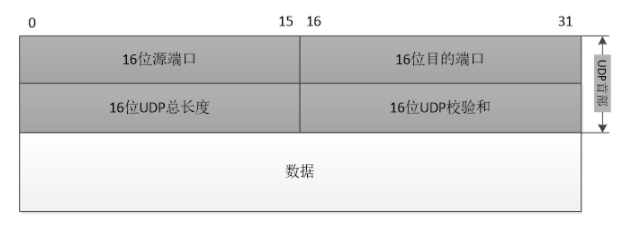
如何使用Netcat命令建立和測試TCP和UDP連接
UDP和TCP的區(qū)別
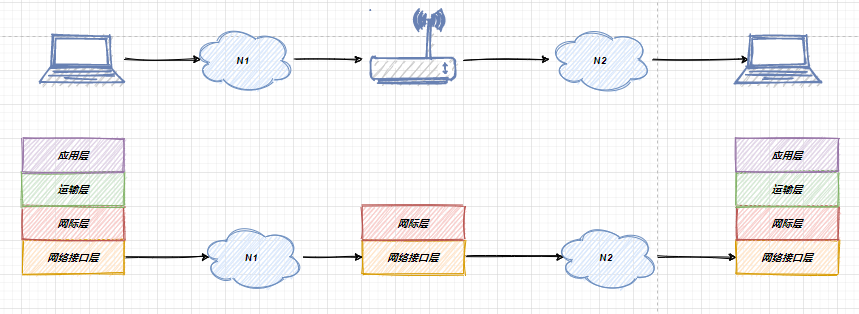
基于Socket的UDP和TCP編程解析 1
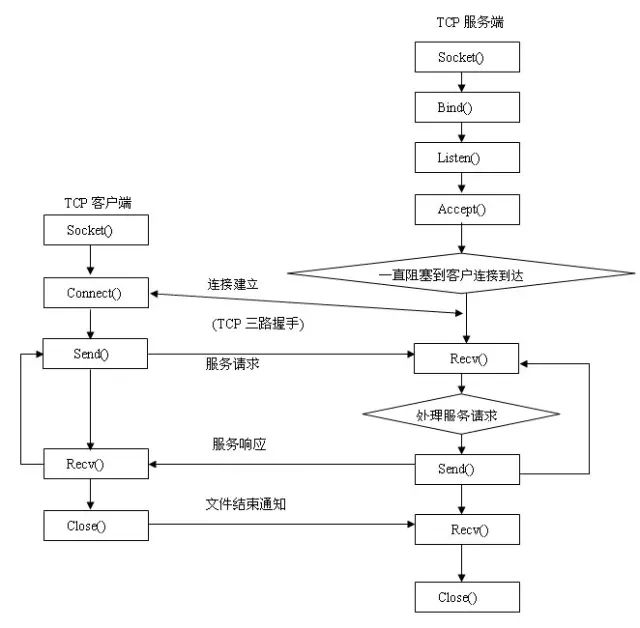
基于Socket的UDP和TCP編程解析 2
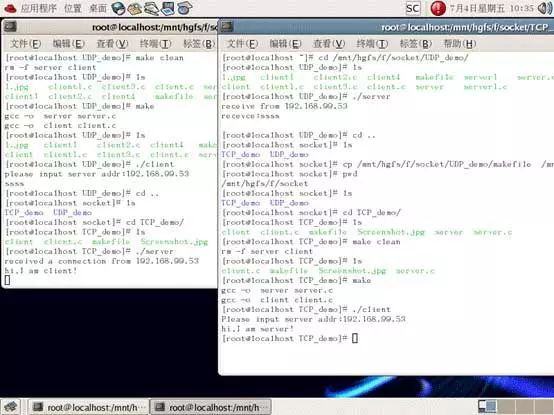




 TCP和UDP連接介紹
TCP和UDP連接介紹
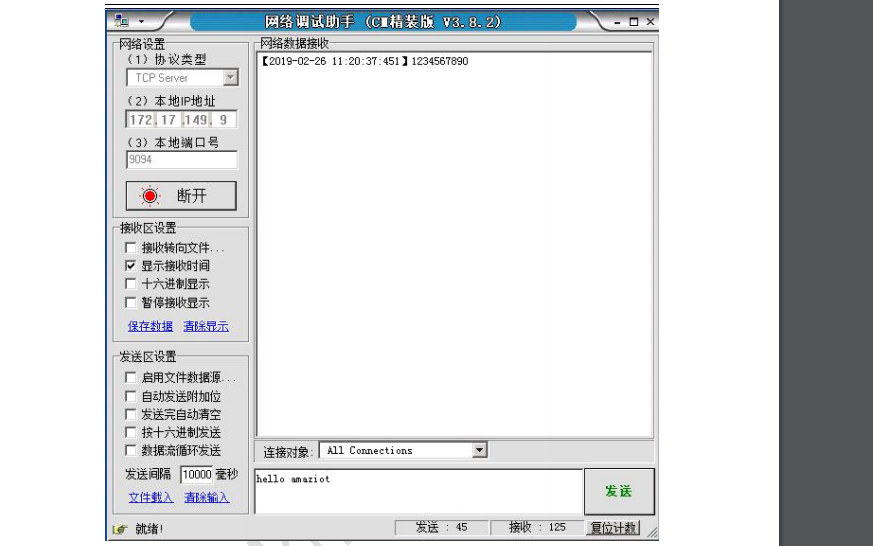
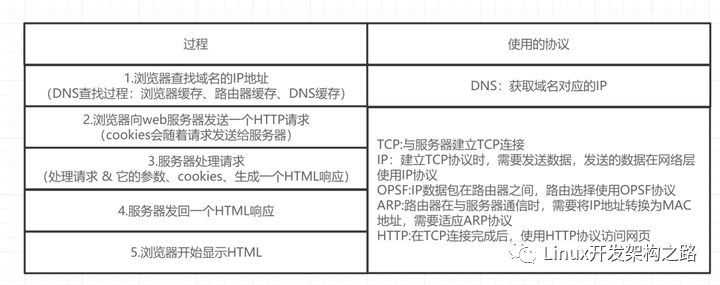
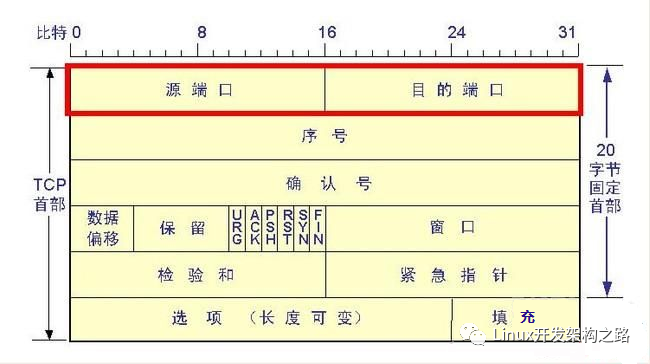










評論